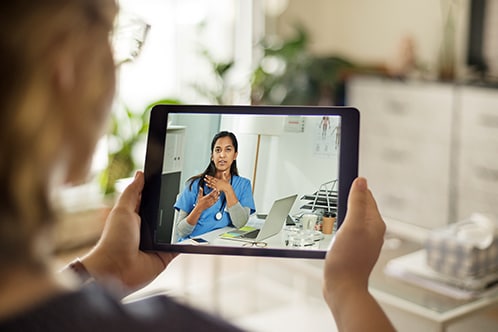Telehealth Interventions to Improve Chronic Disease
The Community Preventive Services Task Force (CPSTF)external icon recommends several telehealth interventions1–4 for reducing chronic disease risk factors in patients and managing chronic disease conditions. These conditions include
- Recently diagnosed cardiovascular disease.
- High blood pressure.
- Cardiovascular disease, diabetes, HIV infection, end-stage renal disease, asthma, or obesity.
Important Definitions
Telehealth is defined differently by different health organizations and government agencies, at both the federal and state level.5–8
In general, telehealth is the delivery of health care through technology such as mobile phones or computers. It can help reduce barriers to care for people who live far away from specialists or who have transportation or mobility issues.9
Related and overlapping concepts10 in this emerging field include the following:
eHealth is an umbrella term that refers to the use of electronic resources and technology to deliver health services. Other terms used as part of eHealth include telehealth, telemedicine, mHealth, and terms based on specific health care fields.
Telemedicine refers to the use of remote clinical services. Examples include videoconferencing for consultations with specialists or transmission of patient or medical information between health care providers.
Mobile Health (mHealth) refers to the use of mobile phones and smart devices to transmit health information.
Telecare refers to the continuous monitoring of emergencies and lifestyle changes related to independent living.
CPSTF’s recommendations for telehealth interventions are based on the findings of four systematic reviews, which are described in more detail in Table 1.
The CPSTF found that the use of telehealth interventions can improve
- Medication adherence, such as outpatient follow-up and self-management goals.
- Clinical outcomes, such as blood pressure control.
- Dietary outcomes, such as eating more fruits and vegetables and reducing sodium intake.
Components of telehealth that have been shown to be effective include
- Text messaging, such as tailored patient education and medication and appointment reminders.
- Web-based content and applications, such as goal-setting and reminder functions on mobile phones.
- Interactive content, such as patients sending health data to their health care provider.
Telehealth Strategies
Telehealth involves health care delivery and education over a distance using electronic and telecommunication technologies.4
The optimal goal for telehealth is for it to be an integral method of providing health care services to the public.
Currently, telehealth can be delivered in several different ways.11 For example,
- Live (synchronous) videoconferencing: This is typically a two-way audiovisual link between health care providers or between a patient and a provider. For example, stroke specialists at different hospitals can communicate about transferring a patient with stroke from one hospital to another for more specialized care.
- Store-and-forward (asynchronous) videoconferencing: This is an exchange of recorded patient health information between providers or between a patient and a provider. For example, community pharmacists can send recommendations about medicines to a patient’s provider through secure e-mail or a patient portal.
- Remote patient monitoring (RPM): This is the use of electronic devices to record a patient’s health data for a provider to receive and evaluate at a later time. For example, a patient can use RPM to measure their blood pressure regularly and send this information to their provider.

CPSTF’s recommendations for telehealth interventions are based on the reviews in Table 1.
mHealth: This refers to health-related applications and programs used on mobile phones and other smart devices. For example, mHealth can include text messages or phone applications that help patients manage their blood pressure and cholesterol levels.
- Audio only: This refers to the use of a landline or mobile phone to connect a patient to a provider. For example, a provider and patient can talk directly about how the patient can manage a chronic disease, condition, or risk factor.
Definitions and policies about what can be covered and reimbursed by public and private insurers also differ. Because definitions of telehealth vary, not every delivery method may be considered telehealth in every jurisdiction. Issues related to patient privacy and confidentiality must also be considered for each method.
Table 1. Systematic Reviews Used to Make Telehealth Recommendations by the Community Preventive Services Task Force (CPSTF)
CDC and Partner Tools and Resources
Public health practitioners and state and local health departments can use these tools and resources to help them implement telehealth programs.
Legislation and Regulation Trackingexternal icon
A mapping resource from the Center for Connected Health Policy, which monitors state and federal telehealth legislation and regulations.
National Consortium of Telehealth Resource Centersexternal icon
A web resource that provides telehealth information, such as fact sheets, guides, checklists, and templates, as well as technical assistance to people who request it. The consortium consists of 12 regional and two national resource centers.
American Telemedicine Associationexternal icon
An organization that focuses on accelerating the adoption of telehealth. It includes technology solution providers and payers, partner organizations, and alliances that can help organizations using telehealth for the first time identify key stakeholders and partners.
Indian Health Service Telehealth Supportexternal icon
A resource that provides telehealth information, including a telebehavioral health tool kit, and support to the Indian Health Service, Tribal and Urban programs.
Disclaimer
Website addresses of nonfederal organizations are provided solely as a service to our readers. Provision of an address does not constitute an endorsement by the Centers for Disease Control and Prevention (CDC) or the federal government, and none should be inferred. CDC is not responsible for the content of other organizations’ webpages. Learn more about the CPSTF membersexternal icon.
